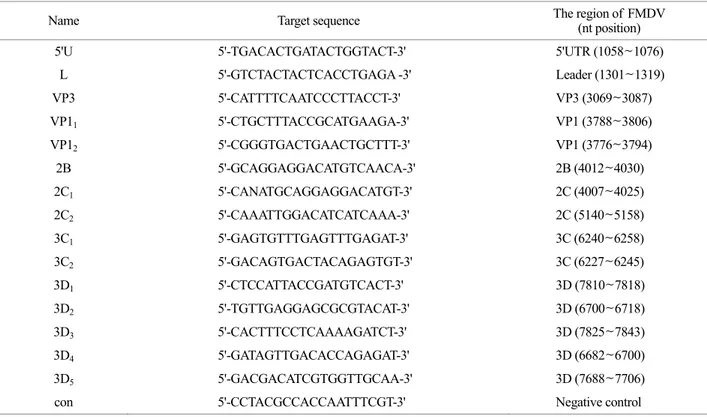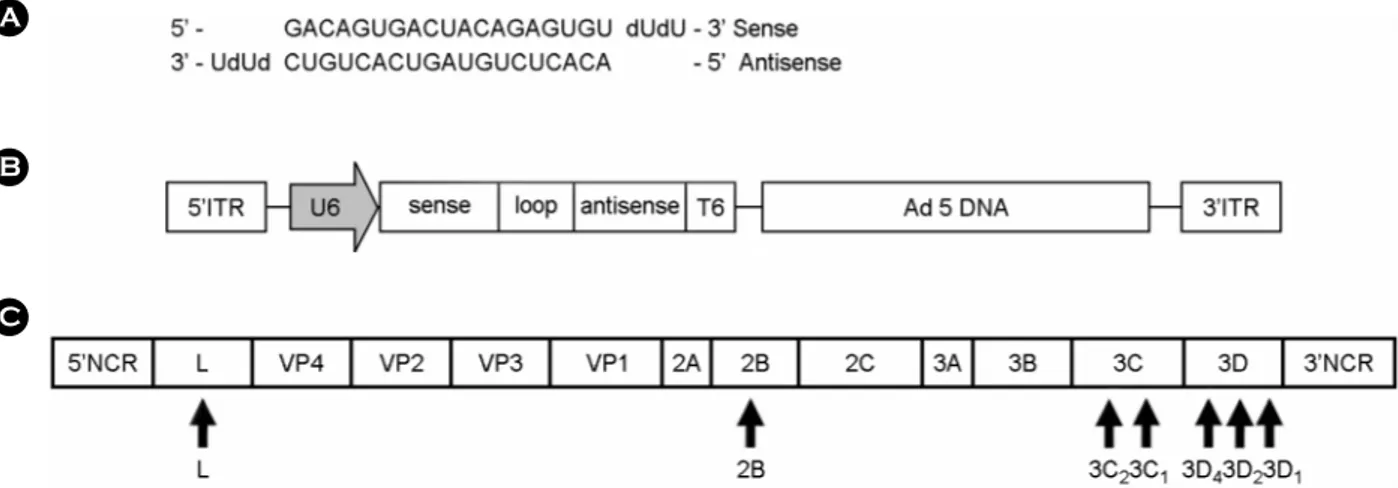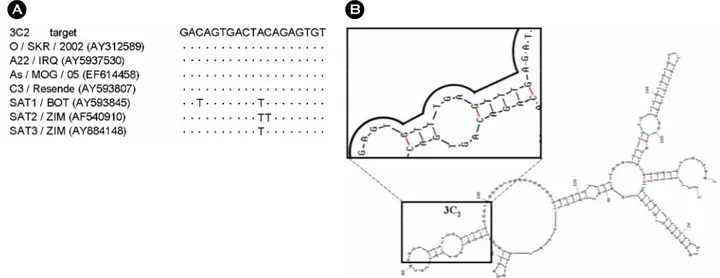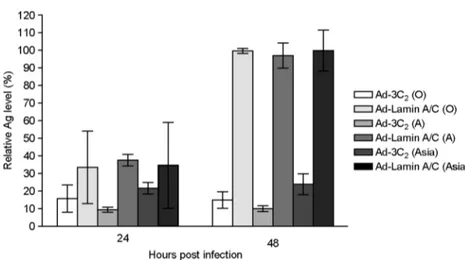Journal of Bacteriology and Virology 2010. Vol. 40, No. 4 p.199 – 206 DOI 10.4167/jbv.2010.40.4.199
Synthetic and Adenovirus Delivered Small Interference RNA Pools Targeting Conserved Regions of Foot-and-Mouth Disease Virus
Su-Mi Kim1,2, Kwang-Nyeong Lee1, Young-Joon Ko1, Yi-Seok Joo1, Hyun-Soo Kim2 and Jong-Hyeon Park1*
1Foreign Animal Disease Division, National Veterinary Research and Quarantine Service, Ministry for Food, Agriculture, Forestry and Fisheries, Anyang, Korea
2Department of Veterinary Medicine, Chungnam National University, Daejeon, Korea
Foot-and-mouth disease (FMD) is an economically significant animal disease because of the speed of its transmission.
Routine vaccination may not be effective for early protection in an outbreak situation. Small interfering RNA (siRNA) can be used as a rapid, effective, and an alternative antiviral approach. In this study, we screened 15 synthetic siRNAs to inhibit FMD virus replication in IBRS-2 cells and selected 10 siRNA sequences. Furthermore, we produced 7 adenoviruses expressing shRNA targeting conserved regions of FMDV, such as a leader sequence and nonstructural protein regions, and showed their antiviral effects. We compared the antiviral effects among them and compared between synthetic siRNAs and adenovirus-delivered siRNAs. In particular, the most efficient siRNA, 3C2, was the conserved sequence in the O, A, Asia 1, and C serotypes of FMDV and was located in the predicted loop structure. The pool of sequences including 3C2 and recombinant adenoviruses could be applied for multiple siRNAs and protection in a broad range of cells and animals.
Key Words: siRNA; Pool; Adenovirus; Antiviral effects
INTRODUCTION
Foot-and-mouth disease (FMD) is a highly contagious disease that affects cloven-hoofed animals such as cattle, swine, and sheep (1). Because FMD virus (FMDV) can spread rapidly between susceptible animals, it is listed by the World Organization for Animal Health (OIE) and is, politically and economically, one of the most important animal diseases in the world. FMDV belongs to the genus
Aphthovirus in the family Picornaviridae (2). The virus genome comprises 8.5 kb of positive-sense, single-stranded RNA containing one open reading frame. There are seven serotypes of FMDV: A, O, C, Asia1, SAT1, SAT2, and SAT3, but numerous subtypes have evolved within each serotype (3, 4).
The phenomenon of RNA interference (RNAi) is mediated by a short hairpin dsRNA (shRNA) and causes gene silencing in a sequence-specific manner. The inhibition of virus replication by RNA interference has been reported for several viruses associated with human disease, including poliovirus, human immunodeficiency virus-1, and hepatitis virus (5~9). Recently, inhibition of FMDV replication using RNAi has been reported. Kahana et al. demonstrated that RNAi could decrease the replication of FMDV in BHK-21 cells (10). A plasmid expressing shRNA that targets the VP1 region (11) and adenoviruses expressing shRNA that 199
Received: April 6, 2010/ Revised: November 23, 2010 Accepted: November 30, 2010
*Corresponding author: Jong-Hyeon Park. Foreign Animal Disease Division, National Veterinary Research and Quarantine Service, Ministry for Food, Agriculture, Forestry and Fisheries, Anyang 430-824, Korea.
Phone: +82-31-467-1719, Fax: +82-31-449-5882 e-mail: parkjhvet@korea.kr
**This work was supported by the National Veterinary Research and Quarantine Service (NVRQS), Republic of Korea.
Original Article
target the 1D and 3D regions (12) have been shown to possess antiviral activity against FMDV in vitro and in vivo.
The use of current FMD vaccines to induce early protection is limited because complete protection cannot be induced until seven days; alternative methods to rapidly reduce the spread of FMDV in outbreak situations are needed. The application of RNAi is one of the possible alternative strategies for FMDV control because it is a rapid and effective antiviral approach.
Adenovirus vectors have several advantages as a delivery system. They are relatively stable and easy to manipulate and can be obtained in high titers. Adenovirus vectors can be administered by various routes such as intranasal, oral, intraperitoneal, intravenous, intramuscular, and subcuta- neous (13), and therefore, can be effectively applied in animals as well. Researchers have reported inhibition of FMDV replication using adenovirus expressing RNAi (12).
In this study, we screened fifteen small interfering RNAs (siRNAs) to inhibit FMDV replication in IBRS-2 cells and selected ten siRNA sequences. Furthermore, we produced seven adenoviruses expressing the shRNA targeting con-
served regions of FMDV and showed their antiviral effects.
MATERIALS AND METHODS Cells, viruses, and virus titration
Human embryonic kidney cells, including human adeno- virus type 5 E1 DNA (293 A cells) and swine kidney cells (IBRS-2) were propagated in Dulbecco's modified Eagle's medium (D-MEM) supplemented with 10% fetal bovine serum (FBS, pH 7.4) at 37℃ with 5% CO2. FMDV isolates of strain O/SKR/2002 (GenBank accession number AY- 312588 and AY312589), A22/IRQ (GenBank accession number AY593753), and As/MOG/05 (GenBank accession number EF614458) were used for the viral challenges.
Virus titers were determined on IBRS-2 cells for FMDV and 293A cells for adenovirus. The 50% tissue culture infective dose (TCID50) was calculated using the formula of Reed and Muench (14).
Design and synthesis of siRNAs
The siRNAs were developed from FMDV O/SKR/2000
Table 1. Target sequences of siRNAs used in this study
Name Target sequence The region of FMDV (nt position)
5'U 5'-TGACACTGATACTGGTACT-3' 5'UTR (1058~1076)
L 5'-GTCTACTACTCACCTGAGA -3' Leader (1301~1319)
VP3 5'-CATTTTCAATCCCTTACCT-3' VP3 (3069~3087)
VP11 5'-CTGCTTTACCGCATGAAGA-3' VP1 (3788~3806)
VP12 5'-CGGGTGACTGAACTGCTTT-3' VP1 (3776~3794)
2B 5'-GCAGGAGGACATGTCAACA-3' 2B (4012~4030)
2C1 5'-CANATGCAGGAGGACATGT-3' 2C (4007~4025)
2C2 5'-CAAATTGGACATCATCAAA-3' 2C (5140~5158)
3C1 5'-GAGTGTTTGAGTTTGAGAT-3' 3C (6240~6258)
3C2 5'-GACAGTGACTACAGAGTGT-3' 3C (6227~6245)
3D1 5'-CTCCATTACCGATGTCACT-3' 3D (7810~7818)
3D2 5'-TGTTGAGGAGCGCGTACAT-3' 3D (6700~6718)
3D3 5'-CACTTTCCTCAAAAGATCT-3' 3D (7825~7843)
3D4 5'-GATAGTTGACACCAGAGAT-3' 3D (6682~6700)
3D5 5'-GACGACATCGTGGTTGCAA-3' 3D (7688~7706)
con 5'-CCTACGCCACCAATTTCGT-3' Negative control
(GenBank accession number. AJ539139) and O/SKR/2002 strain sequences using Blast and Turbo si-Designer Program (Bioneer Corporation, Daejeon, Korea). The target sequences of the siRNAs are summarized in Table 1. The siRNAs were produced and annealed by Bioneer Corporation (Fig. 1A).
Synthesized siRNA transfection and viral challenge in IBRS-2 cells
IBRS-2 cells were transfected with 10 nM each of double- stranded siRNA including fluorescence labeled negative control siRNA by Lipofectamine 2000 (Invitrogen, SanDiego, CA, USA). We checked the transfection efficiency using the fluorescence of negative control. After 12 h of adsorption, the medium was removed and the cells were washed twice with D-MEM. The IBRS-2 cells were infected immediately with 100 μl (100 TCID50/0.1 ml) of FMDV. After 1 h adsorption at 37℃, the inocula were removed and the cells were washed twice with D-MEM.
One hundred microliters of culture medium containing 2%
FBS were added and the cells were incubated at 37℃.
Supernatants were collected 48 h after FMDV infection and were used in the replication analysis of FMDV.
Construction of plasmids
Oligonucleotides of the inverted repeat FMDV target sequence were annealed and cloned into the pENTR/U6 entry vector (Invitrogen) under the control of the U6 pro-
moter and a termination signal consisting of six thymidines (Fig. 1B). To generate a recombinant adenovirus construct expressing the target sequences, we performed a recom- bination reaction with the pENTR/U6 entry construct and pAd/BLOCK-iT-DEST vector (Invitrogen) using an LR clonase II enzyme mix (Invitrogen). The shRNA of the housekeeping gene Lamin A/C was used as a negative control because it lacked any sequence homology with FMDV.
Adenovirus production
Recombinant human adenovirus was produced following the manufacturer's instructions. Briefly, the recombinant adenovirus constructs were linearized with Pac I and purified by ethanol purification. The Pac I digested adeno- virus constructs were transfected into 293A cells using Lipofectamine 2000 (Invitrogen). When approximately 80%
cytopathic effect (CPE) was observed, the adenoviruses were harvested and amplified. Adenovirus stocks of 107 to 108 TCID50/ml were used for the experiment.
Adenovirus-short hairpin RNA (Ad-shRNA) inocula- tion and viral challenge in IBRS-2 cells
IBRS-2 cells were plated to 96-well plates at a concen- tration of 3.5 × 104 cells/well. The next day, a 90%
confluence of IBRS-2 cells was present at the time of infection. Cells were inoculated with Ad-shRNA at 3 × A
B
C
Figure 1. Schematic representation of siRNA generation. (A) Schematic representation of annealed siRNA. (B) Schematic representation of recombinant adenovirus DNA. (C) Diagram of the FMDV full genome. The black arrows indicate the target region of shRNA.
106 TCID50. After 12 h of adsorption, the Ad-shRNA suspension was removed and the cells were washed twice with D-MEM. The IBRS-2 cells were infected immediately with 100 μl (100 TCID50/0.1 ml) of FMDV (this was performed 12 h postinoculation with adenoviruses). After 1 h of adsorption at 37℃, the inocula were removed and the cells were washed twice with D-MEM. Two hundred microliters of culture medium containing 2% FBS were added and the cells were incubated at 37℃. Supernatants were collected at 48 h after FMDV infection and were used in the kinetic analysis of FMDV.
Analysis of FMDV replication in IBRS-2 cells To assay the effect of siRNA or adenovirus-mediated shRNA on FMDV RNA replication, FMDV antigen enzyme- linked immunosorbent assay (ELISA) was performed. The level of FMDV antigen in the supernatants was determined by antigen ELISA using a test kit produced by the Pirbright Laboratory, Institute for Animal Health, UK (15). ELISA was repeated three times and optical density (OD) was changed to the relative antigen level (%), which is per- centage of sample OD to control OD. T-test was performed for statistical analysis by GraphPad InStat (ver 3.05, GraphPad software, La Jolla, CA, USA).
Prediction of RNA secondary structure and sequence alignment
RNA secondary structure of the partial 3C region including 3C2 siRNA sequences, was obtained from the Mfold web server (http://bioweb.pasteur.fr/seqanal/interfaces/
mfold-simple.html). Sequence alignment and editing were performed using CLUSTAL W (16) and the BioEdit program (17).
RESULTS
Inhibition of FMDV replication in IBRS-2 cells by synthesized siRNA
The relative viral protein level was measured at 48 h postinfection (p.i.) using FMDV antigen ELISA. The results show that the relative level (%) of FMD viral protein was reduced in IBRS-2 cells transfected with siRNAs (Fig. 2).
Ten siRNAs showed antiviral effect compared with the negative control siRNA; the antiviral effect of the other five (2C1, 3D3, 5'U, 3D5, and 2C2) was not statistically significant. Among the siRNAs that were found to have antiviral effect, 3C1, 3D1, 3D2, VP11, VP12, 2B, 3C2, 3D4, and L showed more than 80% reduction compared with the no treatment group (FMDV group). They showed superior Figure 2. Inhibition of FMDV repli- cation in IBRS-2 cells by synthesized siRNA. IBRS-2 cells were transfected with 10 nM of each siRNA including negative control siRNA. After 12 h of transfection, the IBRS-2 cells were infected immediately with 100 TCID50 of FMDV (O/SKR/2002).
The relative viral level was measured at 48 h p.i. using antigen ELISA (*p < 0.05, t-test, a statistically significant differences between negative control (con) and others).
Optical density (OD) was changed to relative antigen level (%) which was per- centage of sample OD to negative control OD. Error bars indicate standard deviation (SD).
FMDV inhibition effect compared with the negative control siRNA (Con group) and the values are statistically signifi- cant (p < 0.05). In the cases of VP3 and L, the inhibition effect narrowly satisfied the statistically significant level.
Among the ten siRNAs, two siRNAs (VP11 and VP12)
targeted structural protein, one siRNA (L) targeted leader protease, and the others targeted nonstructural protein regions.
Inhibition of FMDV replication in IBRS-2 cells by adenovirus-mediated shRNA treatment
Among the siRNA sequences that showed antiviral effect, we selected those that targeted the leader protease region or the nonstructural protein, which is the conserved region that inhibits against various serotypes of FMDV replication. We constructed a recombinant adenovirus that expressed the selected siRNAs including 3C1, 3D1, 3D2, 2B1, 3C2, 3D4, and L (Fig. 1C). In 48 h FMDV postinfection, Ad-3C1, Ad-3D1, Ad-3D2, Ad-2B1, Ad-3D4, and Ad-L, all showed statistically significant differences in FMDV replication (p < 0.05) (Fig. 3). Furthermore, Ad-3C2 (p <
0.0001) was the most effective.
Sequence alignment of 3C2 siRNA region for seven serotypes and predicting the location of 3C2 siRNA in RNA structure
We analyzed the 3C2 siRNA target sequences to anticipate against seven serotypes of FMDV (Fig. 4A). The sequences were completely conserved between the O, A, Asia 1, and
Figure 4. Nucleotide sequence alignment of 3C2 siRNA region for seven serotypes of FMDV and RNA structure including 3C2siRNA region. (A) Sequence alignment and editing were performed using CLUSTAL W (16) and BioEdit program (17). (B) RNA secondary structure of the partial 3C region including 3C2 siRNA sequences was obtained from the Mfold web server (http://bioweb.pasteur.fr/
seqanal/interfaces/mfold-simple.html). siRNA 3C2 sequences are included in the magnified figure and nucleotide T (thymine) represents U (uracil) in the RNA structure. Red lines represent G-C pairs and blue and green lines represent A-U and G-U pairs.
Figure 3. Inhibition of FMDV replication in IBRS-2 cells by recombinant adenovirus. IBRS-2 cells were infected with Ad- shRNA at 3 × 106 TCID50. After 12 h of infection, the IBRS-2 cells were infected immediately with 100 TCID50 of FMDV (O/
SKR/2002). The relative viral protein level measured at 48 h p.i.
using antigen ELISA (*p < 0.05 and ***p < 0.0001, t-test, a statistically significant differences between control (Ad-Lamin A/C) and others. Optical density (OD) was changed to the relative antigen level (%), which was percentage of sample OD to negative control OD. Error bars indicate standard deviation (SD).
A B
C serotypes of FMDV, but had sequence variation in the SAT 1 (two mismatches), SAT 2 (two mismatches), and SAT 3 (one mismatch) serotypes of FMDV used in this study.
Furthermore, it was predicted that the 3C2 sequences were located in the loop structure of 3C (Fig. 4B).
Antiviral effects of 3C2 siRNA against O, A, and Asia 1 FMDV
We observed antiviral effects when the adenovirus expressing 3C2 siRNA was applied to O, A, and Asia 1 serotypes of FMDV (Fig. 5). We analyzed the level of FMDV protein at 24 and 48 h p.i. of FMDV. The repli- cations of A and Asia 1 type were significantly inhibited, as were the O type of FMDV. Their protein levels were less than 30% compared with the Ad-Lamin A/C control at 48 h p.i.
DISCUSSION
This study screened siRNAs against O/SKR/2002 and O/SKR/2000 of FMDV. We designed 15 siRNA sequences and detected the antiviral effects of 10 siRNAs. It was reported that the siRNA targeting 5'UTR was less efficient than the siRNAs targeting other regions at inducing antiviral activity in poliovirus, another member of the family Picornaviridae (5). The siRNA targeting 5'UTR did not show significant antiviral effects in this study. However, the siRNA targeting leader sequence had significant antiviral
effects (Fig. 2).
There are two approaches for RNAi. One is to transfect synthesized siRNAs and the other is to express shRNA using a plasmid vector or a viral vector. Though transfecting synthesized siRNA is a simple method, it cannot offer long-term gene suppression (18); therefore, we produced recombinant adenoviruses with shRNA driven by the U6 promoter in this study. The U6 promoter is known as a well characterized and strong pol III promoter and is more efficient than an H1 promoter (19, 20). Chen et al.
demonstrated that shRNA targeting VP1 had an antiviral effect against FMDV in suckling mice (11). However, the antiviral effect of shRNA targeting VP1 was serotype specific; furthermore, adenovirus expressing shRNAs targeting the 1D or 3D region of O type of FMDV showed cross inhibition (12). Therefore, we selected seven siRNAs targeting conserved regions, including a leader sequence and nonstructural protein regions for resistance from escape mutants and for cross-protection in several serotypes of FMDV. Though seven recombinant adenoviruses had antiviral effects, the inhibition effects of the adenovirus- mediated shRNAs did not exactly match those of the synthesized siRNAs (Fig. 2 and Fig. 3). Although synthe- sized siRNAs directly work in cytoplasm, shRNA must be generated in the nucleus before shRNA-mediated viral vectors are able to come out to the cytoplasm. Therefore, even if the same target sequence is expressed, the silencing effect on the target RNA may differ. In this study, 3C2 was the most effective in approaches for both synthesized
Figure 5. Cross-inhibition of Ad-3C2
against O, A, and Asia 1 type of FMDV in IBRS-2 cells. IBRS-2 cells were infected with Ad-shRNA at 3 × 106 TCID50. After 12 h of infection, the IBRS-2 cells were infected immediately with 100 TCID50of FMDV (O/SKR/2002, A22/IRQ, and Asia 1/MOG/05). The relative viral protein level measured at 24 and 48 h p.i. using antigen ELISA. Optical density (OD) was changed to the relative antigen level (%), which was percentage of sample OD to negative control OD. Error bars indicate standard deviation (SD).
siRNA and adenovirus-mediated shRNA. Because the 3C2
siRNA sequence was conserved in O, A, Asia 1, and C types of FMDV (Fig. 4A), the interference was maintained in several serotypes. The alignment coincided with the antiviral effects against O, A, and Asia 1 types of FMDV (Fig. 5). In terms of silencing efficiency, it depended on the structural environment of the target site, as well as the siRNA sequence itself (21, 22). The hairpin structures and loops possibly contributed to the inefficacy of the siRNAs.
However, we found that the 3C2, targeting disordered loop regions, had high efficiency (Fig. 4B). Furthermore, the 3C1
sequence, the functional siRNA, was located in a hairpin structure (data not shown). In other studies, the silencing of siRNA targeting cis-acting replication element (CRE) of human enterovirus B another member of Picornaviridae was not hampered by the stem loop structure and the siRNA had a strong antiviral effect (23).
We screened siRNA sequences in the complete genome for inhibiting FMDV replication and produced synthetic siRNAs and recombinant adenovirus expressing siRNAs.
We compared the antiviral effects among them and synthetic siRNAs with adenovirus delivered siRNAs. The pool of sequences and recombinant adenoviruses could be applied for multiple siRNAs and protection in a broad range of cells and animals. However, we did not show whether escaped mutants against the siRNAs including 3C2 were generated and did not test the duration of the silencing effects of synthetic and adenovirus delivered siRNAs. These issues require further study.
REFERENCES
1) Pereira HG. Foot-and-mouth disease animals. New York, NY: Academic Press, 1981:333-63.
2)Bachrach HL. Foot-and-mouth disease. Annu Rev Microbiol 1968;22:201-44.
3)Domingo E, Escarmís C, Baranowski E, Ruiz-Jarabo CM, Carrillo E, Núñez JI, et al. Evolution of foot-and- mouth disease virus. Virus Res 2003;91:47-63.
4) Knowles NJ, Samuel AR. Molecular epidemiology of foot-and-mouth disease virus. Virus Res 2003;91:65-80.
5) Gitlin L, Stone JK, Andino R. Poliovirus escape from RNA interference: short interfering RNA-target recog- nition and implications for therapeutic approaches. J Virol 2005;79:1027-35.
6) Saulnier A, Pelletier I, Labadie K, Colbère-Garapin F.
Complete cure of persistent virus infections by antiviral iRNAs. Mol Ther 2006;13:142-50.
7)Jacque JM, Triques K, Stevenson M. Modulation of HIV-1 replication by RNA interference. Nature 2002;
418:435-8.
8)Lee NS, Rossi JJ. Control of HIV-1 replication by RNA interference. Virus Res 2004;102:53-8.
9)Hamasaki K, Nakao K, Matsumoto K, Ichikawa T, Ishikawa H, Eguchi K. Short interfering RNA-directed inhibition of hepatitis B virus replication. FEBS Lett 2003;543:51-4.
10)Kahana R, Nakao K, Matsumoto K, Ichikawa T, Ishikawa H, Eguchi K. Inhibition of foot-and-mouth disease virus replication by small interfering RNA. J Gen Virol 2004;85:3213-7.
11) Chen W, Yan W, Du Q, Fei L, Liu M, Ni Z, et al. RNA interference targeting VP1 inhibits foot-and-mouth disease virus replication in BHK-21 cells and suckling mice. J Virol 2004;78:6900-7.
12) Chen W, Liu M, Jiao Y, Yan W, Wei X, Chen J, et al.
Adenovirus-mediated RNA interference against foot- and-mouth disease virus infection both in vitro and in vivo. J Virol 2006;80:3559-66.
13)Souza AP, Haut L, Reyes-Sandoval A, Pinto AR.
Recombinant viruses as vaccines against viral diseases.
Braz J Med Biol Res 2005;38:509-22.
14) Reed LI, Muench H. A simple metheod of estimating fifty percent and points. Am J Hygiene 1938;27:493-7.
15) Roeder PL, Le Blanc Smith PM. Detection and typing of foot-and-mouth disease virus by enzyme-linked immunosorbent assay: a sensitive, rapid and reliable technique for primary diagnosis. Res Vet Sci 1987;43:
225-32.
16) Thompson JD, Higgins DG, Gibson TJ. CLUSTAL W:
improving the sensitivity of progressive multiple sequence alignment through sequence weighting, position-specific gap penalties and weight matrix choice.
Nucleic Acids Res 1994;22:4673-80.
17) Hall TA. Bioedit: a user-friendly biological sequence alignment editor and analysis program for Windows 95/98/NT. Nucleic Acids Symp Ser 1999;41:95-8.
18) Root DE, Hacohen N, Hahn WC, Lander ES, Sabatini DM. Genome-scale loss-of-function screening with a lentiviral RNAi library. Nat Methods 2006;3:715-9.
19) Lo HL, Chang T, Yam P, Marcovecchio PM, Li S, Zaia JA, et al. Inhibition of HIV-1 replication with designed miRNAs expressed from RNA polymerase II promoters.
Gene Ther 2007;14:1503-12.
20) Makinen PI, Koponen JK, Karkkainen AM, Malm TM, Pulkkinen KH, Koistinaho J, et al. Stable RNA inter- ference: comparison of U6 and H1 promoters in endothelial cells and in mouse brain. J Gene Med 2006;8:433-41.
21)Schubert S, Grunweller A, Erdmann VA, Kurreck J.
Local RNA target structure influences siRNA efficacy:
systematic analysis of intentionally designed binding regions. J Mol Biol 2005;348:883-93.
22) de Almeida RS, Keita D, Libeau G, Albina E. Structure and sequence motifs of siRNA linked with in vitro down-regulation of morbillivirus gene expression.
Antiviral Res 2008;79:37-48.
23) Lee HS, Ahn J, Jee Y, Seo IS, Jeon EJ, Jeon ES, et al.
Universal and mutation-resistant anti-enteroviral activity:
potency of small interfering RNA complementary to the conserved cis-acting replication element within the enterovirus coding region. J Gen Virol 2007;88:2003 -12.



